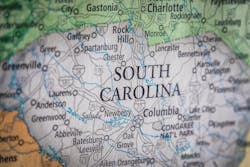RB Simms Treatment Facility Improvements: A Master Class
Submission by Caroline Meiss
Edited by Mandy Crispin
Spartanburg Water is one of the most established water systems in South Carolina. Created in 1929 as the Spartanburg Metropolitan District, the utility has a history of delivering high-quality drinking water to customers.
Spartanburg Water relies on three water treatment facilities and a well-maintained network of pumping stations, lakes, and transmission lines. The RB Simms Water Treatment Facility (RB Simms) was built in 1926 and includes pipes and structural elements over one hundred years old.
In 2019, it was time to upgrade this facility and that’s when the Harper team came on board. The scope of improvements included construction of a raw water feed system consisting of a new 32MGD ozone generation and pre-treatment facility, new 64MGD raw water intake with passive screening on Lake Bowen, and 1,500LF of 64” raw water main to feed the plant. Harper also performed rehabilitation on 9 of the existing 12 filters and built a new bulk alum storage facility.
When chosen as CM At-Risk, Harper spent a lot of time with the client planning the project approach carefully. They knew, however, that this project involved some significant constraints on aging infrastructure and would require a dynamite project team that could think quickly and creatively to deliver the best possible result to reach the expressed goals.
The approach to achieving those goals was to make sure the facility focused extensively on unique, innovative, and achievable solutions to deliver the desired outcome for the clients. “The project involved a masterclass in communication and collaboration between the owner, designer, and general contractors, highlighting the benefits of teamwork in engineering excellence,” said Caroline Meis.
This project also incorporated technology and other advanced solutions to deliver a very complex project. It was important that the water supply at RB Simms maintain its quality for the local community. Coming to the table with unique approaches focused on maintaining operations of the facility during construction was critical. By getting creative in this area, addressing concerns with existing infrastructure and location of the plant, and mitigating any disturbance to the reservoir while also being able to finish our project on time, they completed a project focused on leading with collaboration and ingenuity while maintaining cost and schedule.
From the materials used in construction to the design of the treatment plant, every aspect of the project was carefully considered to ensure that the final product was of the highest quality. By ensuring that the project met owner’s standards and goals, the Spartanburg Water system will provide clean water throughout its community with valuable resources.
Several project challenges arose throughout the construction of the WTF. Maintaining operations during construction was a primary concern for the 64MGD plant. Simple solutions, such as building a new chemical feed storage area at the back of the plant, alleviated delivery coordination. However, installing new water lines under the existing infrastructure provided a more formidable challenge.
The available plans and site layout gave a general idea of what lay underground and plant operators filled in many gaps. Still, the Harper team wanted certainty that they would not cut an electrical wire or drill through an existing water line during construction, they performed extensive imaging and layout exercises to understand how the proposed construction would interact with underground utilities.
This was accomplished using imaging technology including Total Station robotics, LiDAR imaging, and traditional sample boring. The result was a 3D model of the entire construction site, showing existing electrical, water, and utility lines overlayed with the proposed additions. They reviewed the model, quickly identified potential clashes, and revised the drawings accordingly. Seeing the finished product before procurement or construction and adjusting plans accordingly saved time and cost by eliminating rework and extra material purchases.
One example of the benefit of this approach was identifying that the new water and ozone lines crossed or were adjacent to an existing one-hundred-year-old 78” penstock. The accurate site layout provided the team with the data necessary to lay the lines around the penstock with zero service interruption. Before a shovel hit the ground, Harper’s field and project management teams knew the exact location of the penstock, where they needed to dig to avoid touching the structure, and precisely where the pipe would connect once it was across the penstock.
Another collaborative application for Virtual Construction was combining real-time images with approved drawings. The project manager collected 300-600 high-quality aerial images per month using Drone Deploy. The project team overlaid applicable images onto their corresponding drawings to show progress and confirm layout and measurements. These images guided preplanning meetings with trade partners, particularly with a BIM model. During the monthly Owner/Engineer/Contractor meetings, these images provided the client, Spartanburg Water, with a visualization of the project to guide conversations about progress and next steps.
Overall, Virtual Construction allowed this project to move forward with limited interruption to plant operations. Underground imaging avoided costly conflicts between new and existing pipes. Real-time images overlaid on drawings ensured precise foundations and pipe placement. BIM models provided the backdrop for quick decision-making because all parties could see and discuss the proposed end product. And, most importantly, they were able to craft an approach that used Virtual Construction to ease the client’s concerns, prioritize their requests, and exceed their expectations.
Another significant problem that needed addressing in this project was the facility’s location adjacent to Municipal Reservoir #1 and its associated dam, creating a distinctive challenge when operating or updating the plant. Working closely with HDR, Inc. (HDR) as the project’s design engineer, the team laid out an approach focused on mitigating any disturbance to the reservoir while also being able to finish our project on-time.
In order to complete the project for Spartanburg Water, they needed to install a new ozone system. This system would be located very close to the one-hundred-year-old dam and the associated lines for this system would need to run from the water to the treatment facility. Even though the ground along the new pipe path was solid granite, the team did not approve blasting because of its proximity to the dam. The team was required to go back to the drawing board to come up with a solution that would allow us to connect the pipe to the water and plant, without utilizing the unapproved pathway.
The solution resulted in the Harper team contracting a Tunnel boring machine (TBM) to drill horizontally through 250’ of granite along the reservoir. The team dug a 40’x26’ shaft to prepare for the grinding machine. Even though they made significant changes to the plan, they were not willing to jeopardize the client’s project schedule.
Digging the shaft required 24/7 operations for several weeks to meet the project schedule. And at some points, it included using hand tools to remove the granite. Halfway down the shaft, the team built a rest area to provide a storage place for tools and an accessible evacuation zone if necessary.
The 40’ shaft included ventilation, dewatering equipment, soil nailing, conduit, pipes, and cast-in-place concrete as added safety precautions. Leaving out even one of the safety elements could potentially compromise the integrity of the bore shaft. Even though there was a change of plans and an extremely tight schedule, the team prioritized safety and quality and did not cut corners on the deliver of this shaft.
After drilling 20’-30’ per day, the machine broke ground at its designated endpoint, and the team successfully connected the two pipes. The extra time and attention spent on finding an innovative solution to this difficult situation allowed this project to move forward.
One budgetary challenge that Harper faced was finalizing an GMP. To tackle this issue, Harper worked tirelessly to find cost-effective solutions that would not compromise the quality of the project. Harper worked to analyze every aspect of the project and find ways to reduce costs without sacrificing performance.
In addition to budgetary concerns, Harper also had to contend with a dynamic schedule. Spartanburg Water needed the new addition to the R.B. Simms Water Treatment Plant up and running as soon as possible, which meant that there was little room for delay. To meet the schedule, Harper employed a range of project management techniques, including scheduling tools, risk management, and contingency planning. The project team worked diligently to keep the project on track and ensure that every milestone was maintained.
This project faced many safety challenges ranging from permit-required confined space and engineered shoring for an exaction estimated at 40 feet.
During the job site, a total of 187 safety inspections were conducted and various hazards were identified and abated. The field team performed several different types of self-inspections and audits on the job site. OSHA consultative inspection was completed with minimal discrepancies. Senior management conducted safety inspections quarterly and audited “Presence of Safety Reports.” The job site had 42,393 man-hours from Harper General Contractors which resulted in no loss time incidents.
In order to promote safety and provide additional safety protocols, the team performed discussions about safety topics throughout the day as they observed someone approaching the line of performing work unsafely. As demonstrated by our lack of recordable incidents on this job, the extra time taken by the team to review safety certainly paid off. The job site conducted multiple types of safety training that included OSHA 10-hour, OSHA-30, and various competent person training on an as-needed basis in both English and Spanish. Several of the larger subcontractors had previously provided their workers with 10-hour training.
Despite the many challenges that have plagued construction projects over the past years, Harper was ultimately successful in meeting Spartanburg's water needs at the R.B. Simms Water Treatment Plant project. Harper delivered the project within the given time constraints, within budget, and to an exceptional standard of quality. Spartanburg water now has a state-of-the-art water treatment plant that provides clean and safe drinking water to its citizens, thanks to the dedication and hard work of Harper.



